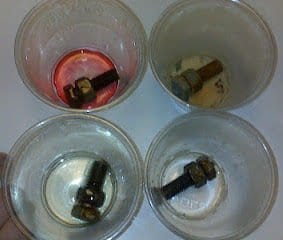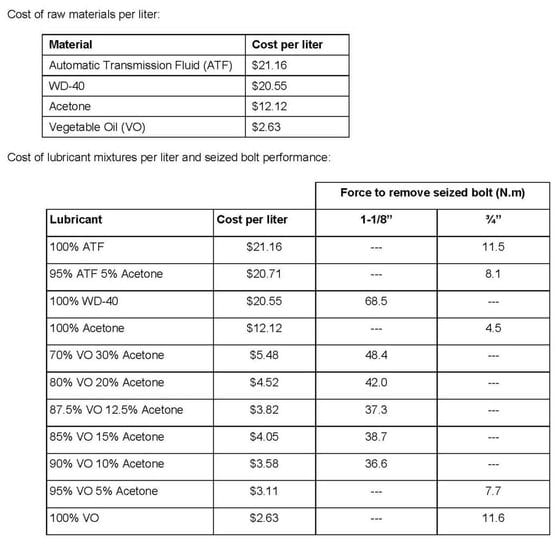August 14, 2012
How to Make Penetrating Oil
contributor: Rob Goodier
 WD 40 lubricating spray may have some low-cost, do-it-yourself competition: vegetable oil and acetone. A mixture of vegetable oil with 10 percent acetone, the active ingredient in nail polish remover and some paint thinners, works as well to free rusted bolts as WD 40. And it costs about one-tenth of the price. Add more acetone, up to 30 percent, and the mixture works even better than WD 40 and still costs about one quarter the price of the commercial spray.
WD 40 lubricating spray may have some low-cost, do-it-yourself competition: vegetable oil and acetone. A mixture of vegetable oil with 10 percent acetone, the active ingredient in nail polish remover and some paint thinners, works as well to free rusted bolts as WD 40. And it costs about one-tenth of the price. Add more acetone, up to 30 percent, and the mixture works even better than WD 40 and still costs about one quarter the price of the commercial spray.
That’s good news for people in rural developing areas where commercial lubricating sprays can be expensive, and vegetable oils are easy to find and even possible to make.
Engineering students at Drexel University in Philadelphia, Penn., made the discovery. They conducted side-by-side comparison tests of vegetable oil mixtures, WD-40 and automatic transmission fluid.
The impetus for their research was a collaboration between two key E4C members: Pat Delany, who is proving to be an idea factory at E4C, had the idea, and Alex Moseson, a professor of engineering at Drexel who develops technologies appropriate for emerging economies.
Vegetable oil with 10% acetone performs as well as WD-40 to free seized bolts. And it costs about one- tenth of the price.
Delany is the creator of the low-cost screw-cutting lathe made from concrete and scrap metal. And Moseson has presided over the development of a seed planter for small-plot farmers and alkali-activated cement with a 97 percent smaller carbon footprint than the ordinary Portland variety, among other projects.
Moseson’s students tested Delany’s hunch that the vegetable mixture may work as well as the commercial spray, and they determined optimum formulas for performance and cost.
The test
The students placed 3/4” and 1-1/8” nuts and bolts in salt and sulfuric acid solutions for one week to rust. Then they applied penetrating oil mixtures and tested the bolts with a torque wrench.
Results

Table by Derek Maruca / Drexel University
Vegetable oil with five percent acetone works as wells as automatic transmission fluid with five percent acetone (used ATF is sometimes substituted for penetrating oil in resource-poor areas). Increasing the acetone content to 10 to 30 percent boosts the mixture’s performance. At that concentration, you can free the seized bolt using less than half of the force that it takes with WD-40.
The bottom line, Moseson tells E4C, is that vegetable oil with 10 percent acetone is more effective at freeing seized bolts than WD-40, it’s as effective as ATF and acetone, and it is more widely available in rural developing areas and kinder to the planet both in manufacture and disposal.
For details, please see the Drexel team’s final report. And here’s a cost and performance analysis by Derek Maruca, a Drexel student who put these tables together for E4C.
Related resources
Drexel team’s penetrating lubricant report (pdf)
How to make a seed planter (at Instructables)
DIY machine shop: Four essential tools you can build from recycled parts
A construction manual for an open source screw-cutting lathe
tags : low-cost resources, penetrating oil, sustainability, transportation innovation





25-03-2018 04:02:39 AM
Stephen says:
06-10-2017 02:15:21 PM
Mac John says:
11-02-2017 08:40:15 PM
Jesse T. Genevish, Jr. says:
13-12-2016 10:08:38 AM
Guido says:
24-10-2016 07:22:58 AM
Peter Mirtitsch says:
11-07-2016 02:27:48 PM
Rob says:
11-07-2016 02:27:37 PM
Rob says:
08-07-2016 06:49:56 PM
ElegantCrowbar says:
12-04-2016 10:09:48 AM
Stephen says:
18-03-2016 04:58:47 PM
Scott Williams says: